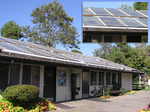Passive solar: Difference between revisions
Lawrencekhoo (talk | contribs) navbox |
rm out of place template |
||
| Line 2: | Line 2: | ||
: ''For the application of passive solar technologies in buildings, see [[passive solar building design]].'' |
: ''For the application of passive solar technologies in buildings, see [[passive solar building design]].'' |
||
[[Image:Laundromat-SolarCell.png|thumb|150px|right|[[Solar hot water panel|Solar panels]] are used in passive and [[active]] [[solar hot water]] systems]] |
[[Image:Laundromat-SolarCell.png|thumb|150px|right|[[Solar hot water panel|Solar panels]] are used in passive and [[active]] [[solar hot water]] systems]] |
||
{{Renewable energy}} |
|||
'''Passive Solar''' technologies are means of using [[solar energy|sunlight]] for useful energy without use of active mechanical systems (as contrasted to [[active solar]]). Such technologies convert sunlight into usable heat (water, air, thermal mass), cause air-movement for [[ventilating]], or future use, with little use of other energy sources. A common example is a [[solarium]] on the [[equator]]-side of a building. [[Passive cooling]] is the use of the same design principles to reduce summer cooling requirements.[http://www.PassiveSolarEnergy.info] |
'''Passive Solar''' technologies are means of using [[solar energy|sunlight]] for useful energy without use of active mechanical systems (as contrasted to [[active solar]]). Such technologies convert sunlight into usable heat (water, air, thermal mass), cause air-movement for [[ventilating]], or future use, with little use of other energy sources. A common example is a [[solarium]] on the [[equator]]-side of a building. [[Passive cooling]] is the use of the same design principles to reduce summer cooling requirements.[http://www.PassiveSolarEnergy.info] |
||
Revision as of 14:01, 19 July 2009
It has been suggested that this article be merged with Passive solar building design and Talk:Passive solar building design#Merge proposal. (Discuss) Proposed since May 2009. |
- For the application of passive solar technologies in buildings, see passive solar building design.

Passive Solar technologies are means of using sunlight for useful energy without use of active mechanical systems (as contrasted to active solar). Such technologies convert sunlight into usable heat (water, air, thermal mass), cause air-movement for ventilating, or future use, with little use of other energy sources. A common example is a solarium on the equator-side of a building. Passive cooling is the use of the same design principles to reduce summer cooling requirements.[1]
Technologies that use a significant amount of conventional energy to power pumps or fans are active solar technologies. Some passive systems use a small amount of conventional energy to control dampers, shutters, night insulation, and other devices that enhance solar energy collection, storage, use, and reduce undesirable heat transfer.
Passive solar technologies include direct and indirect solar gain for space heating, solar water heating systems based on the thermosiphon, use of thermal mass and phase-change materials for slowing indoor air temperature swings, solar cookers, the solar chimney for enhancing natural ventilation, and earth sheltering.
More widely, passive solar technologies include the solar furnace and solar forge, but these typically require some external energy for aligning their concentrating mirrors or receivers, and historically have not proven to be practical or cost effective for wide-spread use. 'Low-grade' energy needs, such as space and water heating, have proven, over time, to be better applications for passive use of solar energy.
External links
- Passive Solar Design
- Passive Solar in Earthship Design
- Canadian Solar Buildings Research Network
- www.greenbuilder.com Passive Solar Design
- Active solar technology for direct space heating or concentrating solar power (photos)
- www.eere.energy.gov US Department of Energy (DOE) Guidelines
- www.ornl.gov Oak Ridge National Laboratory (ORNL) Building Technology
- Residential Green Building Checklist
- Commercial Green Building Checklist
- Passive Solar Design Guidelines
- Passive Solar Design in action
